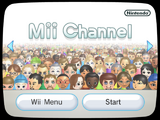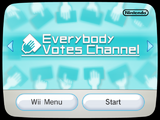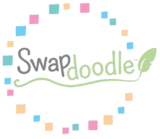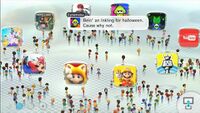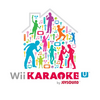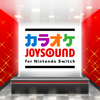Mii (franchise): Difference between revisions
PinkYoshiFan (talk | contribs) |
(Streetpass Mii Plaza is a series according to Smash Ultimate. also created a separated section for Mii games that aren't part of a Mii series, aka Pilotwing and Karaoke Joysound) |
||
| (2 intermediate revisions by 2 users not shown) | |||
| Line 11: | Line 11: | ||
}} | }} | ||
The '''''Mii'' franchise''' is a software franchise consisting of various video games and applications centering around customizable avatars used on every Nintendo | The '''''Mii'' franchise''' is a software franchise consisting of various video games and applications centering around [[Mii]]s, customizable avatars that have been used on every Nintendo console since the [[Wii]] along with a few mobile apps and DS games. | ||
While the franchise properly started with the Wii launch title ''[[Wii Sports]]'' and the pre-installed [[Mii Channel]] application, both being released on the November 19th, 2006 in North America, various other applications and games were | While the franchise properly started with the Wii launch title ''[[Wii Sports]]'' and the pre-installed [[Mii Channel]] application, both being released on the November 19th, 2006 in North America, various other applications and games were planned to have or had the basic concept of customizable avatars. These include an [[Mii Maker#Face Creator (Famicom Disk System)|untitled avatar creator for the Famicom Disk System]], a scrapped Gamecube game titled ''[[pikipedia:Stage Debut|Stage Debut]]'', or ''[[mariowiki:Mario Artist: Talent Studio|Mario Artist: Talent Studio]]''. | ||
The ''Mii'' franchise has somewhat blurry limits as to what game and applications should or shouldn't be considered as part of it, as Nintendo has not given a precise list of games and applications that are part of it, only lifting clues in very few areas. One example is ''[[Super Smash Bros. Ultimate]]'''s spirit section, which uses a Mii icon in order to represent various series under a proper "''Mii''" franchise. Some series, such as ''[[Wii Fit (series)|Wii Fit]]'' and ''[[Swapnote (series)|Swapnote]]'', do not possess the Mii symbol despite the former being a sub-series of the ''Wii'' series and the latter's main character [[Nikki]] being a Mii. Meanwhile, ''Pilotwings'', a series with only one installment that supports Miis (that being ''[[Pilotwings Resort]]'') and even predates the existence of Miis, is still given the Mii icon. | The ''Mii'' franchise has somewhat blurry limits as to what game and applications should or shouldn't be considered as part of it, as Nintendo has not given a precise list of games and applications that are part of it, only lifting clues in very few areas. One example is ''[[Super Smash Bros. Ultimate]]''{{'}}s spirit section, which uses a Mii icon in order to represent various series under a proper "''Mii''" franchise. Some series, such as ''[[Wii Fit (series)|Wii Fit]]'' and ''[[Swapnote (series)|Swapnote]]'', do not possess the Mii symbol despite the former being a sub-series of the ''Wii'' series and the latter's main character [[Nikki]] being a Mii. Meanwhile, ''Pilotwings'', a series with only one installment that supports Miis (that being ''[[Pilotwings Resort]]'') and even predates the existence of Miis, is still given the Mii icon. | ||
No application, game, or subseries can be definitively called the "main" installment of the franchise, and very few of them reference one another, only being linked via the heavy uses of Miis. Amongst those titles are the [[Wii series|''Wii'' series]] (itself composed of smaller series such as the ''[[Wii Sports (series)|Wii Sports]]'' and ''[[Wii Fit (series)|Wii Fit]]'' serie), the ''[[Tomodachi (series)|Tomodachi]]'' series, ''[[Nintendo Land]]'', ''[[StreetPass Mii Plaza]]'', the [[Mii Maker]]s themselves, etc. | |||
The best-selling game in the franchise is currently ''Wii Sports'' | The best-selling game in the franchise is currently ''[[Wii Sports]]'' for the Wii, selling around 82,900,000 copies worldwide and being the fourth best-selling game of all time as of April 2024. | ||
==Applications== | ==Applications== | ||
| Line 25: | Line 25: | ||
===Mii Makers=== | ===Mii Makers=== | ||
In order to create Miis in the first place, various avatar creators were produced over the years and on various hardware, often being directly installed on a console. Some Mii Makers were also included with other games as well, such as ''Tomodachi Collection'' or ''Miitopia''. | In order to create Miis in the first place, various avatar creators were produced over the years and on various hardware, often being directly installed on a console. Some Mii Makers were also included with other games as well, such as ''[[Tomodachi Collection]]'' (an example of being included out of necessity, as the DS did not have system-wide Miis) or ''[[Miitopia]]'' (an example of a game-specific Mii Maker having more features than the system-level one, such as more hair colors). | ||
====Wii==== | ====Wii==== | ||
| Line 87: | Line 87: | ||
===WaraWara Plaza=== | ===WaraWara Plaza=== | ||
{{Main|WaraWara Plaza}} | |||
[[File:Wii-u-warawara-plaza.jpg|A screenshot of the WaraWara Plaza.|200px|thumb|right]] | [[File:Wii-u-warawara-plaza.jpg|A screenshot of the WaraWara Plaza.|200px|thumb|right]] | ||
WaraWara Plaza is the name given to the main system menu of the Wii U, which would show, once the system is turned on, all users' Miis dropping from the sky into the center of the plaza, with various other Miis from Miiverse communities running into the plaza under their associated games icon. | WaraWara Plaza is the name given to the main system menu of the Wii U, which would show, once the system is turned on, all users' Miis dropping from the sky into the center of the plaza, with various other Miis from Miiverse communities running into the plaza under their associated games icon. | ||
| Line 97: | Line 98: | ||
|size=150px | |size=150px | ||
}} | }} | ||
{{Main|Miiverse}} | |||
Miiverse was a social network available for the Wii U that launched with the system in 2012, with web browser and Nintendo 3DS versions also being released later in 2013. Miiverse was also integrated into various games and allowed players to interact and share various messages with other users from all around the world. Every user who had a Nintendo Network ID was automatically given a Miiverse profile represented via the Nintendo Network ID's Mii. | Miiverse was a social network available for the Wii U that launched with the system in 2012, with web browser and Nintendo 3DS versions also being released later in 2013. Miiverse was also integrated into various games and allowed players to interact and share various messages with other users from all around the world. Every user who had a Nintendo Network ID was automatically given a Miiverse profile represented via the Nintendo Network ID's Mii. | ||
{{clear}} | {{clear}} | ||
==Video games== | ==Video games== | ||
Various video games series and other single-installment games that heavily focused on Miis have been released | Various video games series and other single-installment games that heavily focused on Miis have been released since 2006. | ||
===''Wii'' series=== | ===''Wii'' series=== | ||
{{Main|Wii series}} | {{Main|Wii series}} | ||
<gallery class="center" widths="100" heights="100"> | <gallery class="center" widths="100" heights="100"> | ||
WS_boxart.jpg|link=Wii Sports|'''''[[Wii Sports]]'''''<br>(2006) | WS_boxart.jpg|link=Wii Sports|'''''[[Wii Sports]]'''''<br>(2006) | ||
WPl boxart.jpg|link=Wii Play|'''''[[Wii Play]]'''''<br>(2006) | WPl boxart.jpg|link=Wii Play|'''''[[Wii Play]]'''''<br>(2006) | ||
WF_boxart.jpg|link=Wii Fit|'''''[[Wii Fit]]'''''<br>(2007) | WF_boxart.jpg|link=Wii Fit|'''''[[Wii Fit]]'''''<br>(2007) | ||
WM boxart.jpg|link=Wii Music|'''''[[Wii Music]]'''''<br>(2008) | |||
WSR_boxart.jpg|link=Wii Sports Resort|'''''[[Wii Sports Resort]]'''''<br>(2009) | |||
WFP_boxart.jpg|link=Wii Fit Plus|'''''[[Wii Fit Plus]]'''''<br>(2009) | WFP_boxart.jpg|link=Wii Fit Plus|'''''[[Wii Fit Plus]]'''''<br>(2009) | ||
WPa_boxart.jpg|link=Wii Party|'''''[[Wii Party]]'''''<br>(2010) | WPa_boxart.jpg|link=Wii Party|'''''[[Wii Party]]'''''<br>(2010) | ||
WPlM boxart.jpg|link=Wii Play Motion|'''''[[Wii Play Motion]]'''''<br>(2011) | |||
WSWSRCover2.png|link=Wii Sports + Wii Sports Resort|'''''[[Wii Sports + Wii Sports Resort]]'''''<br>(2012) | |||
WKU artwork.png|link=Wii Karaoke U by JOYSOUND|'''''[[Wii Karaoke U by JOYSOUND]]'''''<br>(2012) | WKU artwork.png|link=Wii Karaoke U by JOYSOUND|'''''[[Wii Karaoke U by JOYSOUND]]'''''<br>(2012) | ||
WPaU boxart.jpg|link=Wii Party|'''''[[Wii Party U]]'''''<br>(2013) | |||
WSC_boxart.jpg||link=Wii Sports Club|'''''[[Wii Sports Club]]'''''<br>(2013) | |||
WFU_boxart.jpg|link=Wii Fit U|'''''[[Wii Fit U]]'''''<br>(2013) | |||
NSS_Box_Art.jpg|link=Nintendo Switch Sports|'''''[[Nintendo Switch Sports]]'''''<br>(2022) | |||
</gallery> | </gallery> | ||
| Line 128: | Line 130: | ||
MT 3DS boxart.jpg|link=Miitopia|'''[[Miitopia|''Miitopia'' (3DS)]]'''<br>(Spinoff, 2016) | MT 3DS boxart.jpg|link=Miitopia|'''[[Miitopia|''Miitopia'' (3DS)]]'''<br>(Spinoff, 2016) | ||
MT Switch Cover artwork.jpg|link=Miitopia|'''[[Miitopia|''Miitopia'' (Switch)]]'''<br>(Spinoff, 2021) | MT Switch Cover artwork.jpg|link=Miitopia|'''[[Miitopia|''Miitopia'' (Switch)]]'''<br>(Spinoff, 2021) | ||
</gallery> | |||
===''Streetpass Mii Plaza'' series=== | |||
<gallery class="center" widths="100" heights="100"> | |||
SMP Puzzle Swap Logo.jpg|'''''Puzzle Swap''''' | |||
SMP Find Mii Logo.jpg|'''''Find Mii''''' & '''''Find Mii II''''' | |||
SMP Monster Manor Logo.jpg|'''''Monster Manor''''' | |||
SMP Warrior's Way Logo.jpg|'''''Warrior's Way''''' | |||
SMP Mii Force Logo.jpg|'''''Mii Force''''' | |||
SMP Flower Town Logo.jpg|'''''Flower Town''''' | |||
SMP Ultimate Angler Logo.jpg|'''''Ultimate Angler''''' | |||
SMP Battleground Z Logo.jpg|'''''Battleground Z''''' | |||
SMP Slot Car Rivals Logo.png|'''''Slot Car Rivals''''' | |||
SMP Market Crashers Logo.png|'''''Market Crashers''''' | |||
SMP Feed Mii Logo.png|'''''Feed Mii''''' | |||
SMP Mii Trek Logo.png|'''''Mii Trek''''' | |||
SMP Ninja Launcher Logo.png|'''''Ninja Launcher''''' | |||
</gallery> | </gallery> | ||
| Line 147: | Line 166: | ||
</gallery> | </gallery> | ||
== | ===Mii games from Non-Mii series=== | ||
<gallery class="center" widths="100" heights="100"> | |||
PR boxart.jpg|link=Pilotwings Resort|'''''[[Pilotwings Resort]]'''''<br>(2011) | |||
== | KJS_artwork.png|link=Karaoke Joysound Switch|'''''[[Karaoke Joysound Switch]]'''''<br>(2017) | ||
</gallery> | |||
Revision as of 18:39, 14 May 2024
| Details | |
|---|---|
| First installment | Wii Sports (game) Mii Channel (software) (both released the same day) |
| Platform(s) | Nintendo DS Wii Nintendo 3DS Wii U iOS/Android Nintendo Switch |
The Mii franchise is a software franchise consisting of various video games and applications centering around Miis, customizable avatars that have been used on every Nintendo console since the Wii along with a few mobile apps and DS games.
While the franchise properly started with the Wii launch title Wii Sports and the pre-installed Mii Channel application, both being released on the November 19th, 2006 in North America, various other applications and games were planned to have or had the basic concept of customizable avatars. These include an untitled avatar creator for the Famicom Disk System, a scrapped Gamecube game titled Stage Debut, or Mario Artist: Talent Studio.
The Mii franchise has somewhat blurry limits as to what game and applications should or shouldn't be considered as part of it, as Nintendo has not given a precise list of games and applications that are part of it, only lifting clues in very few areas. One example is Super Smash Bros. Ultimate's spirit section, which uses a Mii icon in order to represent various series under a proper "Mii" franchise. Some series, such as Wii Fit and Swapnote, do not possess the Mii symbol despite the former being a sub-series of the Wii series and the latter's main character Nikki being a Mii. Meanwhile, Pilotwings, a series with only one installment that supports Miis (that being Pilotwings Resort) and even predates the existence of Miis, is still given the Mii icon.
No application, game, or subseries can be definitively called the "main" installment of the franchise, and very few of them reference one another, only being linked via the heavy uses of Miis. Amongst those titles are the Wii series (itself composed of smaller series such as the Wii Sports and Wii Fit serie), the Tomodachi series, Nintendo Land, StreetPass Mii Plaza, the Mii Makers themselves, etc.
The best-selling game in the franchise is currently Wii Sports for the Wii, selling around 82,900,000 copies worldwide and being the fourth best-selling game of all time as of April 2024.
Applications
While video games are generally regarded as the Mii franchise's most iconic titles, various applications were created alongside them on various hardware.
Mii Makers
In order to create Miis in the first place, various avatar creators were produced over the years and on various hardware, often being directly installed on a console. Some Mii Makers were also included with other games as well, such as Tomodachi Collection (an example of being included out of necessity, as the DS did not have system-wide Miis) or Miitopia (an example of a game-specific Mii Maker having more features than the system-level one, such as more hair colors).
Wii
Mii Channel
(2006)
Nintendo DS
Tomodachi Collection
(2009)- Kuruma de DS.png
Kuruma de DS
(2012)
Nintendo 3DS
Mii Maker
(2011)Tomodachi Life
(2013)Miitopia (3DS)
(2016)
Wii U
Mii Maker
(2012)
Nintendo Switch
Mii Maker
(2017)Miitopia (Switch)
(2021)
Other
Miitomo
(2016)Pikmin Bloom
(2021)
Wii Channels
The Wii console has various other applications, called "Wii Channels", available to be used in order to do all sorts of things, such as looking at various photos, checking the recent news and upcoming weather, etc. While some Wii Channels were pre-installed, others had to be downloaded, making it hard to use them due to the closure of the Wii Shop Channel, as well as most channels' own servers having shut down.
Amongst the various Wii Channels, some had Mii-focused activities, such as the Everybody Votes Channel, in which the player could use their Mii and send it to the world in order to represent them during various debates; the Mii Channel, which allows the player to create Miis; the Japanese-exclusive channel Wii no Ma, in which Miis were a big part of, with the player's family being represented by Miis and even had some Mii-focused items available to buy, such as stamps and calendars; and the Check Mii Out Channel, which allowed to send and download Miis from all around the world.
Mii Channel
(2006)Everybody Votes Channel
(2007)- Check Mii Out.jpg
Check Mii Out Channel
(2007) Wii no Ma
(2009)
Swapnote series
The Swapnote series is a series composed of messaging applications and a Japanese-exclusive Club Nintendo game, all hosted by a Mii named Nikki and her friends. All three games in the series were released on the Nintendo 3DS.
Swapnote
(2011)Nikki no Tabisuru Quiz
(2015)Swapdoodle
(2016)
WaraWara Plaza
- Main article: WaraWara Plaza
WaraWara Plaza is the name given to the main system menu of the Wii U, which would show, once the system is turned on, all users' Miis dropping from the sky into the center of the plaza, with various other Miis from Miiverse communities running into the plaza under their associated games icon.
Miiverse
- Main article: Miiverse
Miiverse was a social network available for the Wii U that launched with the system in 2012, with web browser and Nintendo 3DS versions also being released later in 2013. Miiverse was also integrated into various games and allowed players to interact and share various messages with other users from all around the world. Every user who had a Nintendo Network ID was automatically given a Miiverse profile represented via the Nintendo Network ID's Mii.
Video games
Various video games series and other single-installment games that heavily focused on Miis have been released since 2006.
Wii series
- Main article: Wii series
Wii Sports
(2006)Wii Play
(2006)Wii Fit
(2007)Wii Music
(2008)Wii Sports Resort
(2009)Wii Fit Plus
(2009)Wii Party
(2010)Wii Play Motion
(2011)Wii Party U
(2013)Wii Sports Club
(2013)Wii Fit U
(2013)Nintendo Switch Sports
(2022)
Tomodachi series
Tomodachi Collection
(2009)Tomodachi Life
(2013)Miitomo
(Spinoff, 2016)Miitopia (3DS)
(Spinoff, 2016)Miitopia (Switch)
(Spinoff, 2021)
Streetpass Mii Plaza series
Swapnote series
Swapnote
(2011)Nikki no Tabisuru Quiz
(2015)Swapdoodle
(2016)
Single installment games
StreetPass Mii Plaza
(2011)Pilotwings Resort
(2011)- Kuruma de DS.png
Kuruma de DS
(2012) AKB48+Me
(2012)Nintendo Land
(2012)
Mii games from Non-Mii series
Pilotwings Resort
(2011)Karaoke Joysound Switch
(2017)











